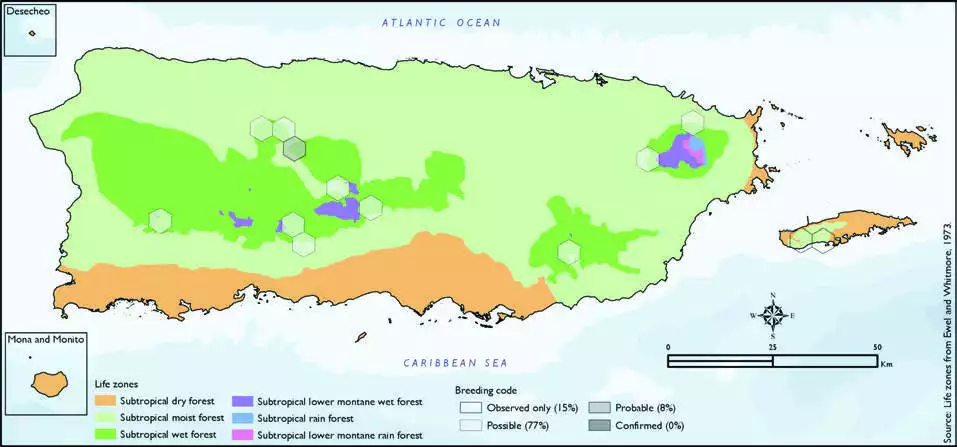Broad-winged Hawk
Description
The broad-winged hawk (Buteo platypterus) is a medium-sized hawk of the genus Buteo. During the summer, some subspecies are distributed over eastern North America, as far west as British Columbia and Texas; they then migrate south to winter in the Neotropics from Mexico south to southern Brazil. Other subspecies are all-year residents on Caribbean islands. As in most raptors, females are slightly larger than males. Broad-winged hawks' wings are relatively short and broad with a tapered, somewhat pointed appearance. The two types of coloration are a dark morph with fewer white areas and a light morph that is more pale overall. Although the broad-winged hawk's numbers are relatively stable, populations are declining in some parts of its breeding range because of forest fragmentation.
Distribution & Habitat
The Broad-winged Hawk is a rare and endemic non-
migratory subspecies in Puerto
Rico (Raffaele and others
1998), mostly restricted to
El Yunque National Forest,
and in Carite and Río Abajo
Commonwealth Forests, where
it is most abundant (Oberle
2018). However, it has also
been reported for the Toro
Negro, Maricao, and Guajataca
Commonwealth Forests (J.A.
Salguero-Faría, personal
observation 2009). It is an
extremely rare visitor in Vieques (Gemmill 2015). Currently,
this species is restricted to
dense broadleaf forests in the
mountains (Oberle 2018, Raffaele
and others 1998). The atlas
fieldwork yielded a total of 15
records within 13 hexagons or 3
percent of the 479 total hexagons
(see map). Of the 13 hexagons
where this species was found,
breeding met the atlas definition
of probable in 8 percent (1) and
possible in 77 percent (10), while
the species was observed in 15
percent (2) of the hexagons but
without evidence of breeding
(see map). Broad-winged Hawk distribution. The map shows the highest breeding code by hexagon and overlaying the ecological life zones in
Puerto Rico. Note: percentages may not total 100 due to rounding. 171Broad-winged Hawk/Guaraguao de Bosque

Breeding Habits
Previously published reports indicate that the Broad-winged
Hawk builds a large bulky
stick nest in a tree or on a cliff
from January to July (Raffaele
and others 1998), but most of
the nesting activity occurs in
February and March (Oberle
2018). Atlas results indicate that
breeding activity for this species
peaks in April, suggesting this
species may also breed outside
of the period described in the
literature. Results show that the Broad-winged Hawk mostly
breeds within the subtropical
wet and subtropical moist forest
life zones (73 and 27 percent of
the hexagons, respectively) (see
table and map).
Conservation
Overall, the Broad-winged Hawk (B. platypterus) is listed as a
species of least concern by the
IUCN (BirdLife International
2016). Locally, however, the
subspecies (B. p. brunnescens) is
listed as critically endangered by local laws (PRDNER 2015) and
as endangered by Federal laws
(USFWS 1973). In Puerto Rico,
the Broad-winged Hawk has a
protected habitat in land of 34
percent or 106 km2 of the total area covered by the hexagons
where evidence of breeding was
found for this species (311 km2).
Related Species
Family:
hawk